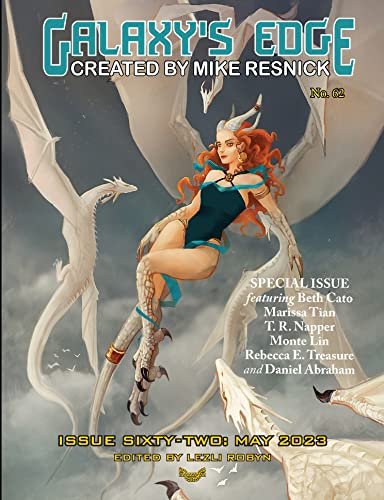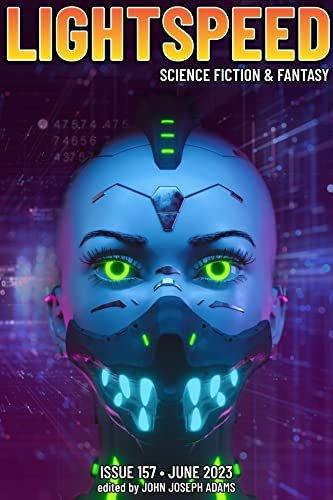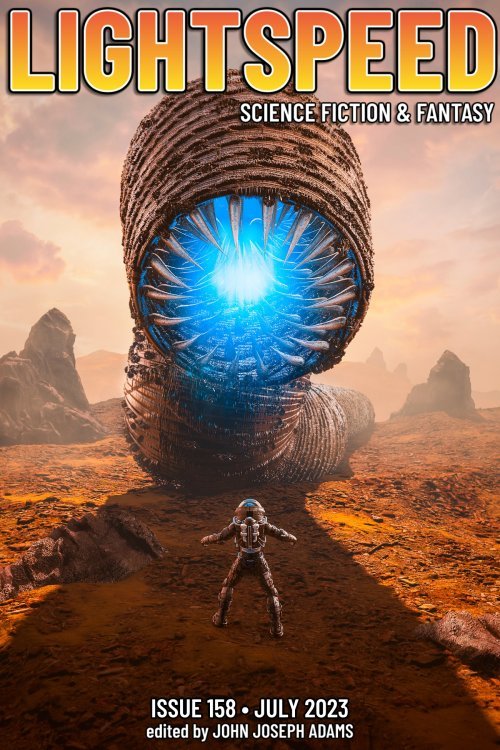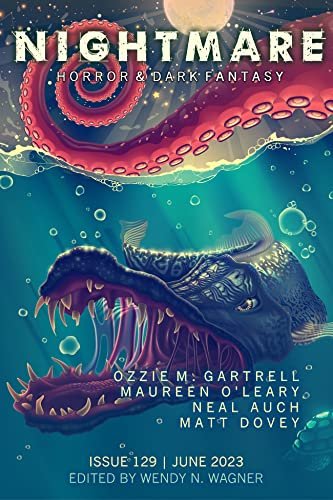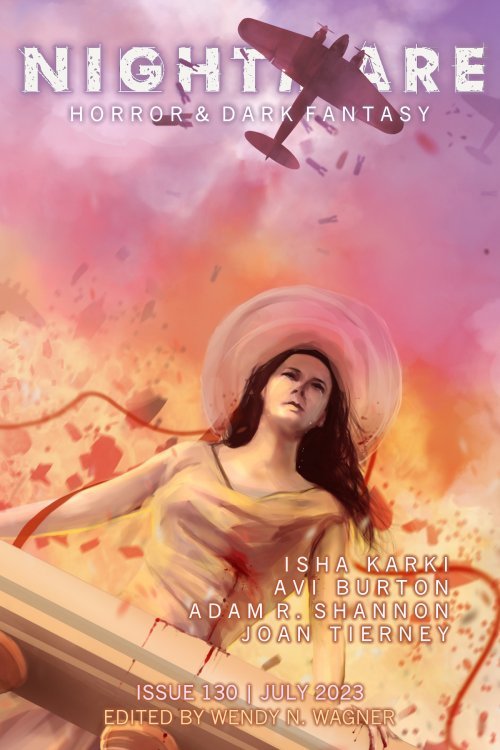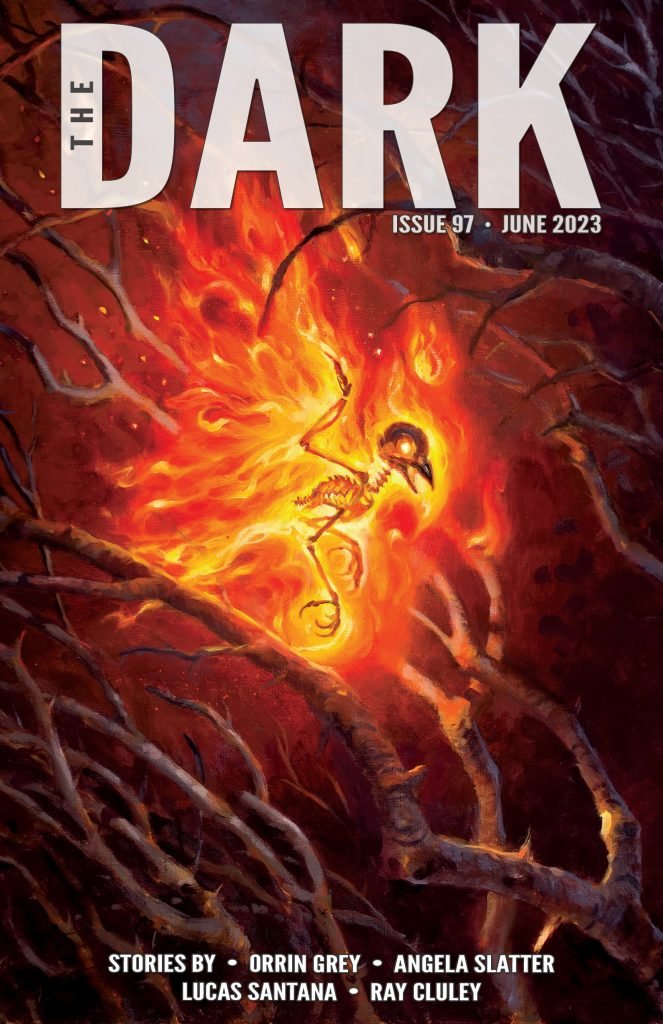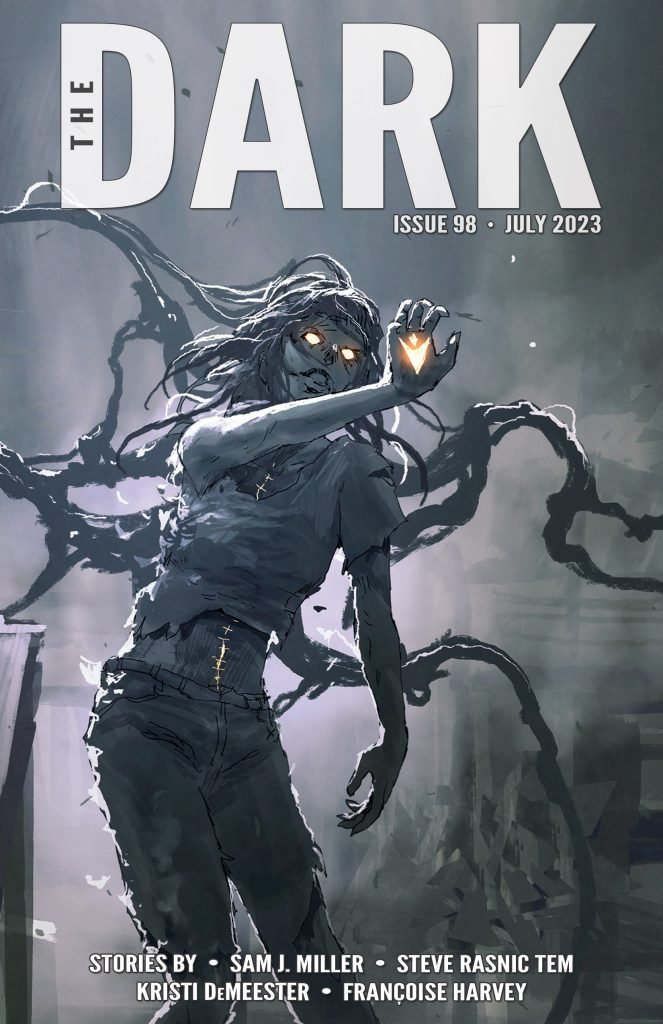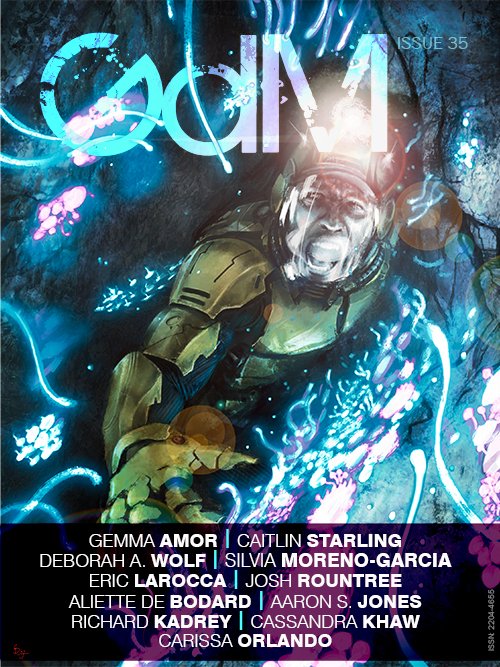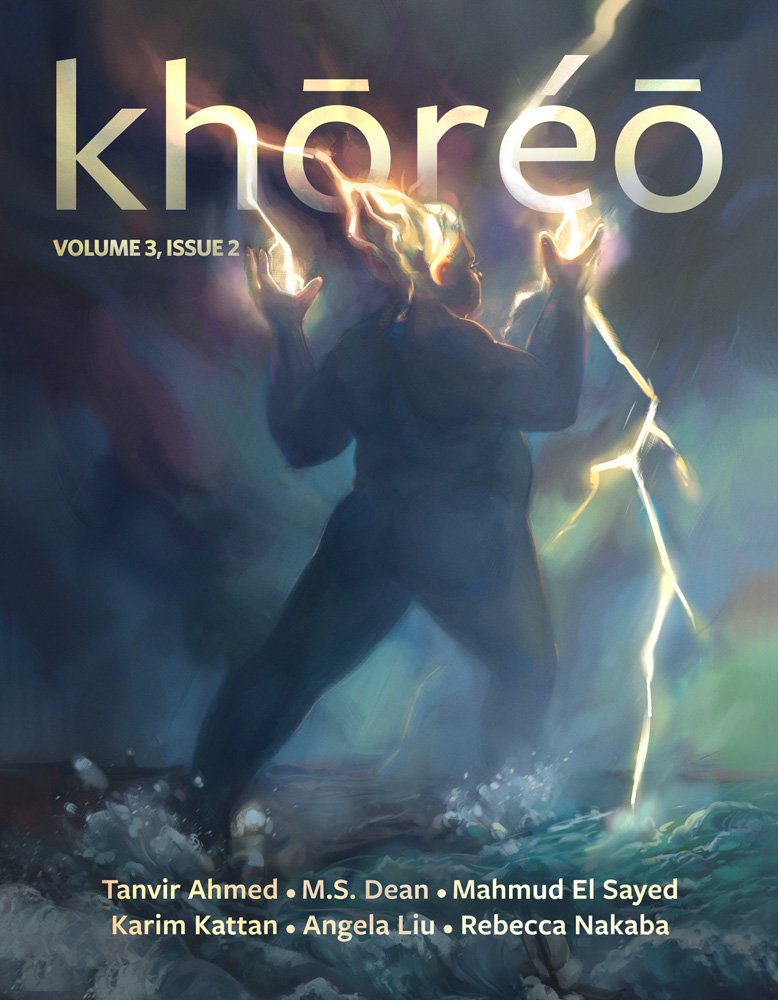Galaxy’s Edge 62 Lezli Robyn, ed. May 2023
This was the terminal issue of Galaxy’s Edge as a monthly magazine, as it transitions into a semiannual anthology. As a bonus to readers, it came with 22 stories ranging across a wide variety of styles and SFF genres.
Among the fiction highlights: Xauri’EL Zwaan’s Fruiting Bodies is an amusing tale of an alien invasion thwarted by ordinary folks, including a Pabst-swilling good old boy who just wants his toaster back. The Inconsistant Heart, by Kari English, is a fun retelling of a classic fairytale trope. Deborah L. Davitt uses Pablovision to explore what might happen if an artist’s vision of the world were a little too real. A Feast of Memories by R.D. Harris looks sweetly at loss and grief, using a unique lens. Planned Obsolescence by Auston Habershaw has an assassin selling out his clients when they ask for a little too much, bathed in a whiff of overpowering cynicism. Mike Resnick is featured with The Bride of Frankenstein, which reimagines that classic tale with a very different perspective. Storm Humbert also has a new take on a classic fantasy/horror idea of possession, Carrion.
The nonfiction section was compact but interesting, anchored by an interview (editor Lezli Robyn talks with Daniel Abraham) and a set of recommended books from Richard Chedwyk. This latter one set me up for one of the weirder reads of recent times: David Boop’s High Noon on Proxima B, which appears alongside–among other rather serious-looking books–a Salman Rushdie novel. I only read the former. Alan Smale’s Turning Points essay looks at the Mongols and their impact, and the issue concludes with L. Pendelope discussing Using Mythology and Cultural Studies In Your Worldbuilding, a thoughtful take on bringing readers into a literary world.
Overall, this felt more like a “last of” than a “best of” edition, with the fiction in particular coming across as varying very widely in style and approach–both fine–but also in quality, which was less fine. The bar was still set pretty high here, and I feel like I discovered this magazine too late. I’m intrigued to see what the new incarnation of the publication will be like.
Smirk factor: All clear: 2 pts (4 smirks in three stories by three different authors.)
Immersion factor: Shallow water: 1 pt (The good stuff was really good, but my mileage varied very widely.)
Writing quality: Above-average: 1.5 pts
Character/plot development: Above-average: 1.5 pts
Innovative/interesting: Average: 1 pt
Total: 7/10 (3.5 stars)
Nightmare Magazine 129, Wendy N. Wagner, ed. June 2023
A short PSA: This month (well, technically, last month’s issue but I’m behind) opens with a somber note: Nightmare, like many publications, is steering into a bit of a headwind with the looming end of Kindle Periodicals. Editor Wendy N. Wagner asks that readers consider subscribing to the magazine through alternate channels. I’ve been getting copies monthly through Weightless Books, one of the suggested alternatives, and am switching to a subscription starting with the August issue. If you enjoy Nightmare Magazine or any of the many other genre publications affected by Kindle Periodicals’ winding down, please consider doing likewise.
Now, on to the June issue:
The fiction, they might say, is strong in this one. Ozzie M. Gartrell leads with The Seconds Between Light and Sound. The story crackles with the same energy as the storm Gartrell’s characters must sail into. Lovingly crafted, it was hard not to imagine the smell of salt water as I read it. Neal Auch’s and its place remembers it no more is a short but chilling picture of a businessman on the path of exploitation acquires a spectral companion, leading to his metaphorical and literal hollowing-out. They Say, by Matt Dovey, sees a Faerie being bullied; the ugliness of the emotions drips off the pages of this tightly-written short. Maureen O’Leary rounds out the section with the sweet and slightly morbid poem Bog Girls.
Non-fiction is also strong this month. The June H-Word is helmed by a neuroscientist. Jonathan H. Smith writes about the neuroscience of fear. Adam-Troy Castro has a strong review of Night’s Edge and Renfield for the vampirically curious, as well as a book on the fiftieth anniversary of The Exorcist. (This last makes it sound like demonic possession may have been the least of the issues with the franchise.) Xander Odell has a delightful Author Spotlight with Ozzie Gartrell, and Leighanna DeRouen discusses Neal Auch’s take on inner demons and other more mundane problems.
Smirk factor: All clear: 2 pts (“Smirk” has been banished from these pages.)
Immersion factor: Chest-high: 1.5 pts
Writing quality: Above-average: 1.5 pts
Character/plot development: Above-average: 1.5 pts
Innovative/interesting: Above-average: 1.5 pts
Total: 8/10 (4 stars)
Nightmare Magazine 130, Wendy N. Wagner, ed. July 2023
The July issue opens with another interesting column from the editor, who dives deep into history and brings back the Amityville Horror, setting the stage for the issue’s focus on “Financial Horror”–or in one case, Real Estate Horror. (This is a thing, of course, but normally in the real world.)
The fiction selection was mixed. Isha Karki’s Sell Your Trauma for Salvation is a bleak and dyspeptic story of a world where trauma can be harvested and eaten, and “compassion” doesn’t mean what these people seem to think it means. I found the writing choppy, although I’d guess this was in service to keeping the cadence high and emphasizing the narrators’ desperation. First in Fear and Then in Pain is Adam Shannon’s story of an accident victim who lives in a haunted house purchased from friends whose real estate business apparently specializes in them. This has a somewhat more positive ending, although one that’s delivered through liberal use of kinetic home remodeling.
There were two shorter pieces: Anatomy of a Haunted House by Avi Burton came out of a writing prompt: “kitchen spirits are the friendliest ghosts.” There’s not much evidence of friendliness in this very short story, but there is a sprig or two of dark humor poking through the grimness. Joan Tierney’s Why Are You Haunted? asks a simple question, or rather a series of them. There may be no good answers, but certainly some will be scary. They’re both original and interesting, if very short, reads.
Nonfiction: this was a really interesting month for the magazine. My overall impression was of two pairs of contrasting narratives, presented in two parts. First off, Zachary Rosenberg’s The H Word: My Journey into Jewish Horror is a fascinating if sometimes shrill look into how one’s identity can be projected into and understood with reference to a very specific genre of literature. It’s followed by Emily Hughes’ longish and exciting review of Silvia Moreno-Garcia’s Silver Nitrate. Both deal with genre and identity, but Hughes’ perspective is 180 degrees out from Rosenberg’s. She dismisses genre labels as “merely a marketing afterthought.” He emphatically centers his identity, at least in literary terms, in one of them. It’s an interesting contrast, sketched out by two talented and compelling writers.
Rounding out the magazine, Xander Odell does another strong author spotlight, focused on Isha Karki. Devin Marcus capably profiles Adam R. Shannon. Here again there’s a fascinating difference in perspective:
Karki’s narrators don’t seem so much act, as exist to be acted upon by huge and sinister forces. Reading the spotlight, I briefly thought I’d wandered into an issue of “Jacobin”–“capitalism” comes up four times in about as many pages (referencing it as a “devouring force” and then citing the “ravages of”, “precarity of” and “bodies under the crushing pressure of” it, respectively.) These and related grievances seem heartfelt enough, if somewhat rote–and lends her writing a suitably grim aura.
A paramedic, Shannon concludes that “Nurturing other living things is the only bulwark I’ve found against real horror.” Perhaps unsurprisingly, he also accords his protagonist significantly more agency than Karki did. First in Fear ends with Carey starting to shape her future, with help from Alma, who has stopped seeing her as a customer and reframed her as a friend. I expect that I’d probably find Karki’s writing more challenging and engaging, but there’s no question that I’d rather live in Shannon’s world.
That’s not fundamentally a criticism. I highlight the two sets of differences to point out that Nightmare Magazine, while easy to poke fun at for sometimes Taking Horror (A Little Too) Seriously also curates and presents some very diverse and very thought-provoking perspectives. I appreciate so many of the pieces here precisely because I don’t necessarily agree with them. But they make me think, and I want to engage with the ideas behind many of the pieces in the magazine precisely because they challenge me. And for that, I appreciate the work that goes into each issue.
Smirk factor: All clear: 2 pts (Has the team every let anyone use that lazy word? I doubt it.)
Immersion factor: Chest-high: 1.5 pts
Writing quality: Above average: 1.5 pts
Character/plot development: Above-average: 1.5 pts
Innovative/interesting: Above average: 1.5 pts
Total: 8.0/10 (4.0 stars)
The Dark Magazine 97, Clara Madrigano and Sean Wallace, eds. June 2023
This month’s edition features four well-crafted tales with a theme of haunting and possession. The God of the Overpass by Orrin Grey is an intense and unsettling story of a woman’s descent into madness after surviving a bloody car crash, and the deadly obsession that results. The Promise of Saints by Angela Slatter is also a tale of obsession, darkness and death, revolving around a possessive and jealous religious relic. Matchstick Girl, by Lucas Santana (translated by H. Pueyo) revolves around a haunted sugar mill manor house in Brazil, and the deadly outcome when foreigners meddle with its history. Finally, The Hufaidh Sounder from Ray Cluely explores the misadventures of a burned-out British ex-soldier deep in the southern Iraqi marshes, where honor is a matter of life and death but not everything is what seems. As seemingly always, this was an excellent collection of finely-written and carefully-curated stories – a tribute to both the editors’ and authors’ craft.
Smirk factor: All clear: 2pts (It almost goes without saying, but...)
Immersion factor: Full-body: 2 pts (Short can be compelling.)
Writing quality: Above-average: 1.5 pts
Character/plot development: Above-average: 1.5 pts
Innovative/interesting: Above-average: 1.5 pts
Total: 8.5/10 (4.25 stars)
The Dark Magazine 98, Sean Wallace, editor. July 2023.
This issue brings four more beautiful short stories, all exploring different facets of relationships which disappoint or otherwise go wrong. If Someone You Love Has Become a Vurdalak by Sam J. Miller is nominally a vampire story, but delves into the cost of living with and around a family member who can’t stop sucking a loved one dry emotionally. In Gavin’s Field, Steve Rasnic Tem visits a son brought by an inheritance to a New England town that’s having the life sucked out of it by a hidden power. A Ritual for Pleasure and Atonement by Kristi DeMeester explores a chilling intersection where hunger and darkness collide. And in Red Red Rose, Bare Bare Bones, Francoise Harvey brings us along on a strange and haunting ritual.
Smirk factor: All clear: 2pts (It almost goes without saying, but...)
Immersion factor: Full-body: 2 pts (Short can be compelling.)
Writing quality: Above-average: 1.5 pts
Character/plot development: Above-average: 1.5 pts
Innovative/interesting: Above-average: 1.5 pts
Total: 8.5/10 (4.25 stars)
Lightspeed Magazine 157 John Joseph Adams, Ed. June 2023
Quite the mix in this densely-packed issue. It opens with the editor reassuring readers that the team is committed to careful driving and pedestrian safety. This makes more sense than it might otherwise. While not the object of the editor’s comments, the strongest story this month was Deborah L. Davitt’s Philoctetes in Kabul. This story traces the tragically normal case of a veteran whose PTSD comes with Homeric overtones. Clever without being insensitive, this was touching and humane.
SF: Dominique Dickey’s Spaceship Joyride is about two hormonal, joy-riding teenagers who hotwire a spaceship, without quite thinking it all through. A classic teen story, updated for 2023. Jaywalk the Stars by Elab Haber explores crossing against the light, so to speak, and impact (pun intended) that can have on life and love. Ruth Joffe’s Queen of the Andes is the tale of the last puya raimondii left on a devastated Earth, and the complexities its keepers endure as what may be the last chance to leave rolls closer. Rich Larson’s Always Personal traces a murder investigation in a dystopian near-future.
Fantasy: The Bone Gatherer is Wendy Nikel’s spare but delicate tale of an oddly compelling character who wanders a desert and gathers more than bones. And All the Fields Below, by Sarah Grey is a touching ghost story featuring a very good boy who has trouble letting go. Kyle E. Miller’s Bestiary viventum explores the complications of living with a collection of magical and mystical creatures.
The excerpts were from Lilith Saintcrow’s forthcoming Spring’s Arcana, described as “American Gods vs. Baba Yaga” and Ariel Kaplan’s The Pomegranate Gate, a Spanish Inquisition trilogy “inspired by Jewish folklore.” The shared theme is clear. Neither would be in my typical reading queue so I appreciated the glimpse into them. The books reviewed varied pretty widely: Aigner Loren Wilson starts with Catriona Ward’s Looking Glass Sound, which blends elements of “weird, horror and mystery” with a deft eye for relationships and twisty plot. Arley Sorg looks at Alex Woodroe’s collection Dark Matter Presents: Monstrous Futures. Sorg offers glimpses of several stories, culminating in a “highly recommended” rating. Chris Kluwe rounds it out with a review of The Will of the Many, by James Islington. This appears to be a recrafted Roman Republic lightly dusted with elements of magic, backed by what Kluwe praises as strong writing.
Would I buy any of them? I found Saintcrow’s writing vivid and alive with mystery and menace in a way Kaplan’s didn’t quite reach. While Spring’s Arcana tempts, it runs into my aversion to paying paperback prices (or what used to be paperback prices–inflation and all that) for an e-book. This, I know, isn’t a completely rational response – the other thing that price buys is professional review and editing. But I also have a lot of unread stuff. Looking Glass Sound sounds like a miss as well. Sorg’s thoughts on Monstrous Futures got me looking Dark Matter Ink up on line, and perhaps, sampling one of their magazines. Watch this space. And The Will of the Many sounds interesting, but at 630 pages… So for this month, it’s a “probably not.”
The issue winds up with some fascinating author spotlights by Laurel Amberdine. Amberdine opens with Dominique Dickey explaining how Spaceship Joyride got to be what it is and putting in an unexpected plug for reading non-fiction as a way to learn how others think. Bravo! Sarah Grey offers praise for dogs (also bravo!) and some very down-to-earth perspectives on writing. Ruth Joffre offers an interesting (and technical?) description of writing Queen of the Andes. Finally, Debroah L. Davitt talks Philoctetes, Afghanistan, and her “slightly ridiculous” pile of projects.
Smirk factor: All clear: 2pts (Again, 1 smirk only)
Immersion factor: Chest-high: 1.5pts
Writing quality: High: 2 pts
Character/plot development: Above-average: 1.5 pts
Innovative/interesting: Above-average: 1.5 pts
Total: 8.5/10 (4.25 stars)
Lightspeed Magazine 158 John Joseph Adams, Ed. July 2023
The Bodhi Tree Asks Only For the Safe Return of Her Beloved is Ashok K. Banker’s longer-form (almost 9800 words) dialog between a human diplomat and a sentient fig tree which has successfully back mankind into a corner demanding the return of its arboreal partner. The first part of the story is almost magical as Banker peels away the tree’s history and story. The dénouement was a bit predictable but opens the possibility of humanity falling under rule of a dictatorship by a tree.
SF: Six Months After All Life on Titan Died by J.B. Park is a 1,762 word satirical commentary on unhinged AI writing prompts–spoiler alert: at this point, forget about AI and just finish the damn story already, ok? Oluwatomiwa Ajeigbe’s Death is Better is heartfelt cry about the drive to be free. The United Systems Goodwill Concert Series and the Greatest Performance of All Time by James Van Pelt is a trippy, pointed concert review.
Fantasy: Nic Anstett starts us off with Monsters of the Drunken Shore, a short story about spring break, an unlikely vision, an awakening...and eight shots of Svedka and a Jägerbomb. Sandara McDonald’s Starpoop was a painful read about memory. Lauren Bajek presents The Real Worlds, in which a family goes camping in spacetime. Muna in Barish by Isha Karki is a searing tale of intersectional oppression.
For excerpts we are given a section from The Deep Sky by Yume Kitasei, dealing with the beginning of the aftermath of an explosion on a deep space probe. Book reviews: The Book of Witches edited by Jonathan Strahan. Arley Sorg finds this collection marks Strahan as “among the best anthologists I’ve read.” Surely no small praise. He Who Drowned the World by Shelley Parker-Chan sketches out a majestic main character whose intensity gives Aigner Loren Wilson chills. Finally, Chris Kluwe looks at Alexander Darwin’s The Combat Codes and finds fantastic worldbuilding and copious violence, but this is deeper than a “meathead book for meathead fighters.”
Would I…no, not this month. Tempted by The Deep Sky, since the current unfulfilling industrial mil SF I’m reading leads me in severe need of a palate cleanser. But this is not to be, given my relatively low reading rate this month and enormous existing queue.
Finally, author spotlights. Laurel Amberdine can’t coax more than a few words at a time out of J.B. Park, perhaps mirroring their extremely spare website, https://maybepark.com/ – there are some good stories there, worth checking out. Sandra McDonald spills about foster parenting, being older than Monet, and some details about writing as well. Ashok N. Banker uncovers the origin story behind her story about The Bodhi Tree and her hopes for the future. And finally, Isha Karki discusses the hope that Muna in Barish will be understood as “warm and hopeful” and so out of mode she’s been in for “about a decade.” And the story–which I read soon after her utterly bleak contribution to Nightmare 130–was maybe a step in that direction. A small one.
Smirk factor: All clear: 2pts (Again, 1 smirk only)
Immersion factor: Chest-high: 1.5pts
Writing quality: High: 1.5 pts (Dragged down a bit by the fantasy section, which aside from “Bodhi” ranged from odd to strident.)
Character/plot development: Above-average: 1.5 pts
Innovative/interesting: Above-average: 1.5 pts
Total: 8/10 (4 stars)
Grimdark Magazine #35, Beth Tabler, ed. July 2023
The magazine opens with Caver, Continue. Caitlin Starling, an author from whom I’d love to read more, opens with a deliciously crafted tale of deceit, desperation and–just maybe–a little hope. Not for the claustrophobic. Eric LaRocca’s We Have Always Been This Way is a dark and weird (or weirdly dark?) look at a confrontation between two opponents in a deadly and grinding culture-clash turned hot war. I’ve read something short by LaRocca before, but it didn’t leave much of an impression. This story makes me think I should take another look. The impressive Aliette de Bodard brings Lullaby for a Lost World; this is a haunting, beautifully-wrought story of murder and revenge. Josh Rountree paints a fantastic picture of moral grayness in Last Pale Light in the West. Pro tip: before setting out to track down the Devil, think twice about what happens when you find him. And rounding out the volume, Gemma Amor presents the fantastic No Secrets Here, in which justice is richly and truly served.
We get two review/interview pairings: First up, Silvia Moreno-Garcia is ably interviewed by Fabienne Schwizer, who also pens a review of her new novel, Silver Nitrate. The interview offers a fascinating look into a very talented author’s world-view. I loved Moreno-Garcia’s shout-out to shlocky horror meistro Dario Argento, who was an early and frightening influence on me. The review also got me thinking hard about buying the novel, with Schwizer offering a bridge from its occult horror roots to a Grimdark shading Moreno-Garcia brings to her characters. Then John Mauro looks at The Dead Take The A Train, by Cassandra Khaw and Richard Kadrey. I think Khaw’s an utter gem of a writer; this offers up her collaboration with Kadrey as a potential new read–maybe by way of discovering some of his nonfiction, which I hadn’t heard of before. Tabler and Mauro also interview Khaw and Kadrey; both interviews are excellent.
Mauro also reviews The Militia House, by new novelist John Milas, who draws on his time as a Marine in Afghanistan to craft a horror story about US troops—mired in that figurative haunted house of a war—who manage to get mired in the middle of a literal haunted house. Mauro’s dissection of the novel’s strengths and weaknesses is great, and elevates that to my to-read list as well. Mauro’s third review is Isabel Cañas’ The Vampires of El Norte. This blends “horror, romance and historical fiction” in the shadow of the Mexican-American War. And vampires. Another one that looks strong.
Aaron S. Jones looks at The Comfort in Horror, which is pretty much what it sounds like. It’s also an interesting inversion of the idea that horror serves only to petrify or traumatize. It bookends nicely with Deborah Wolf’s fantastic essay Weird Horror, which ably presents a slightly different side of things. Beth Tabler interviews Carissa Orlando, who has a forthcoming novel, The September House. Orlando is a practicing psychologist, and from the interview it sounds like writing horror may be a promising endeavor.
Smirk factor: All clear: 2 pts
Immersion factor: Full-body: 2 pts (Read this in pretty close to one sitting, then read it again.)
Writing quality: High: 2 pts
Character/plot development: Above average: 1.5 pts
Innovative/interesting: Above average: 1.5 pts
Total: 9/10 (4.5 stars, rounded to 5)
This is a quarterly magazine “of speculative fiction and migration...elevating the voices of immigrant and diaspora authors.” I found it as a speculative purchase on Weightless Books, and was very pleased with it. There was nothing bad in this, and I loved the breadth of the authors’ perspectives and styles.
Fiction starts with The Abode of the Palms by Karim Kattan, narrating the struggle of a narrator charged with murdering a sibling, and the supernatural ‘friend’ who lends aid. Compelling, with a rich narrative. Sartor from Tanveer Ahmed starts with the wonderful phrase, “They say…” and stretches out a fascinating tale of a dervish’s severed head. Umeboshi is Rebecca Nakaba’s vision of a chain email which sparks a strange and wondrous voyage. M.S. Dean offers Come Back, Crocodile Bird, a deceptively simple but satisfyingly deep exploration of the search for lost family in the midst of a climate catastrophe. Mahmud El Sayed’s Memories of Memories Lost explores a world in which memories have become currency, and the tradeoffs and sacrifices these impose. Finally, Kwong’s Bath by Angela Liu is a hauntingly sad tale of transformation and, inevitably, loss on many levels.
Illustration: https://www.sabaadraws.com/
Smirk factor: All clear: 2 pts (Only 1 “smirk”, describing an actual smirk.)
Immersion factor: Chest-high: 1.5 pts
Writing quality: High: 2 pts
Character/plot development: Above-average: 1.5 pts
Innovative/interesting: High: 2pts
Total: 9/10 (4.5, rounded to 5 stars)

